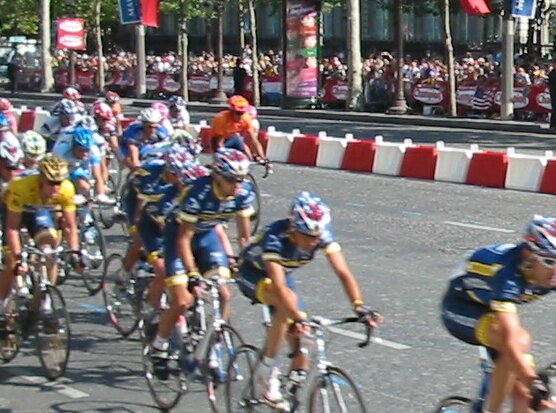Storytelling Science
The Science of Bicycle Racing
Amitabha Mukerjee
I am leaning out precariously on a ledge overlooking the avenue Champs Elysses in Paris, trying to photograph Lance Armstrong as he rides past on his way to become the first man to win the Tour de France six times. The crowd is huge, upto twenty people deep in places all along the 163 km course. Today is the final day of this gargantuan race which has covered 3,391 gruelling kilometers, including some of the steepest mountains in the Alps.
Suddenly, the pack of bicyclists (le peloton), show up. In just a few seconds, all 147 have zipped by, going at 45-50 km/hr as the sprinters race to win today's stage.

The pack of Tour de France riders in Paris July 25: The yellow jersey at (extreme left) is Lance Armstrong. In the foreground, his teammates (in blue), protect him from accidents. [Photo: author]
How Racing Bicycles are Different
50 kmph? Most of us are lucky if we make 20 km/hr on a bicycle, and then we surely can't keep it up for hours, let alone days. [To try it seriously, find some flat roads (say, a 40 km circuit) and try to do it in two hours.] One factor is that racing bicycles are different . . . And here are some of those differences:
- Lightweight Frame : The set of big rods joined together in the middle of your bicycle is its frame. It is the most important part of the bicycle, since everything else can be interchanged. The frame must be light so you can accelerate quickly. Modern racing bicycles use composites (moulded carbon fibers) which are very light — most racing bikes weigh about 8 Kgs.
- Rigid Frame: To be comfortable while riding, the bicycle frame also acts as its suspension. This also means that every time you pedal forcefully, some of your energy goes into bending the frame. So racing bicycles sacrifice comfort for speed (as do racing cars) and use very stiff frames. A big advantage of composite frames is that they can absorb the road shock despite being very stiff.
- Gears : Our legs work best only in a narrow range of forces and rhythms. What you want is that your legs should keep spinning at this optimal force and rhythm, though your bike may be climbing up or accelerating downhill. This is what gearing does — it amplifies your leg force differently depending on the slopes and racing conditions, so that you can keep your "cadence" at a comfortable rate — around 60 rpm for us mortals, and around 100 rpm for racing cyclists.
- Wind resistance: When you bicycle on level ground, what are you pedaling against? The rolling friction on smooth ground is very low for hard-pumped tires; at racing speeds, wind is what you are fighting the most. Cycle spokes add to the drag because they whiz at twice your speed when at the top of the wheel. This is why racing bicycles often cover the spokes with a disk cover — but only on the rear wheel usually because crosswinds at the front can destabilize steering.
- Cleated Pedals : You may have experienced this: you are pushing down with a lot of force but suddenly your foot slips off the pedal. Painful - but can also be rather dangerous. Most racing pedals have "cleats" that let the rider lock his boot (with a matching part) onto the pedal. These also enable "angling" where a rider angles his foot so as to get maximum torque for a larger part of the stroke.
But the Main Difference is the Bicyclist
These are some of the key technologies in modern bicycle racing. But time and again it has been shown that technology does not count for nearly as much as the bicyclist.
Some years back I was on a ride from Kanpur to Lucknow with some students. After reaching Lucknow I was zipping down the Ganj on my French racing bike, when a man with an ordinary bicycle easily pulled past me. Eventually we started talking, primarily about where I'd gotten my bicycle from. I can't remember his name now — maybe it was Shamsur Khan — but he was from rural UP and had won many medals in bicycling, and gone to the nationals, training on his ordinary gear-less bike. We parted at a fork on the road and I never saw him again, but undoubtedly he was a far strong bicyclist than I can ever be.
Increase your own speed today: Your legs push most efficiently when they are stretched out (check out this physics!). Racers have very tall seats so their leg is stretched out fully at the bottom of the stroke. Try adjusting your own seat higher (and make sure your tires are pumped up hard) — you will feel the difference immediately. Later, you should lower your seat to a safe height, so you can get off quickly when needed! Nonetheless, most Indian bicycle seats are far too low!
Do you know a kid who loves bicycling? Why not sit with him (or her) today and help tune his bike for speed? Who knows, you may be able to light a dream, and after all, it is only dreams that we can live by.
-------
When he is not riding bicycles recreationally (or watching races), Amitabha Mukerjee (mukerjee gmail.com) teaches Computer Science at IIT Kanpur.